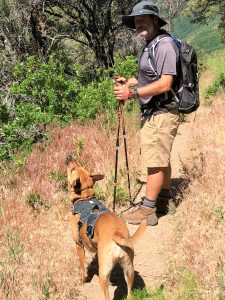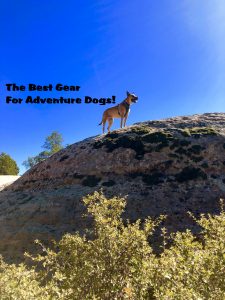
With our dogs, understanding age, ability, and attentiveness means human, know what your dog is capable of before taking it with you on your OUTventure.

Chris & Mac
We outventure to help you outventure!
Support Grey Otter Outventures!
Please help us continue to bring you great content:
When it comes to dogs, understanding age, ability, and attentiveness helps us ensure they have fun, and are safe outdoors. In other words, human, know your dog’s capabilities before taking it with you on your OUTventure.
DOG HEALTH – UNDERSTANDING AGE AND ABILITY
The age of a dog affects their OUTventure experience, but may have lifelong consequences for their health. Understanding the connection helps us avoid inadvertently injuring or causing them pain when they are either very young or elderly.
Start Slow With Young Dogs
Able and eager, young dogs can and will run for long periods on the trail. Because they have seemingly endless stores of energy we figure if they can keep up with us then they are fine. Unfortunately, for a dog which is still growing, this thinking can result in growth plate injuries. Since full discussion of this issue is not our intent here, the bottom line is: Take it slow until your dog has had time to grow. If you have questions, check with your veterinarian. Otherwise, keep the adventures shorter and slower while they are young and you will help ensure they enjoy many years of happy, healthy adventuring with you.
End Slow With Elderly Dogs
Just like us humans, our aging dogs eventually slow down. You may notice your dog has less stamina, or moves slower than it used to. If so, then dial back the adventure to a level that is less taxing, but still fun for them. If, however, you notice a limp or a favored side then exercise greater care. This is because our dogs often develop mobility or joint issues as they age. For these dogs, walking or running for an extended period is not just tiring, it is painful. If you see signs of discomfort, please check in with your veterinarian. He or she may have tips or treatments to help you keep your dog safely OUTventuring comfortably.
DOG SAFETY – UNDERSTANDING ATTENTIVENESS
A dog’s attentiveness matters because it helps us keep them and us safe on an OUTventure. Whereas we know dogs are excellent OUTventure companions, we must acknowledge that the less attentive ones can pose a safety risk. Whether the dog is on leash or off leash, an attentive dog is simply a safer OUTventure buddy. Here’s why: An attentive dog will immediately respond appropriately to sit, stay, hold, come, leave it, go up or down, over or under… or any other command we give to direct their behavior. Following commands helps keep them and us from harm.
On Leash Safety for Us
On leash, dog and human are tethered together, and must move in unison. As such, an leashed dog that does not follow commands could get us hurt. Consider descending a steep, rocky section of trail together. Although a dog can descend quickly, a human must move slower because the terrain is sketchy. If the dog won’t “slow” or “hold” they can cause the human to tumble downward. In every OUTventure situation, this is the primary concern about an on leash dog: Ignoring our commands could get us injured. Until you can trust them to follow your on leash commands, do yourself a favor and stay away from situations where their inattention to your commands could harm you.
Off Leash Safety for Them
Off leash, the physical link between dog and human is broken. As such, off leash dogs can quickly get into trouble. It is thus critical to train off leash dogs to 100% respond to voice commands. For instance, exuberant unleashed dogs have charged, skidded, or slipped and fallen over the edge of cliffs or been swept away by swift currents. Further, many have taken off after a wild animal, never to be seen again. Frankly, all of them might as well be wearing bumper stickers proclaiming: If it will run, then chasing it is fun!
Thus to keep them safe, we must train them to respond to our voice commands without fail. If we spot a potential hazard, a voice command allows us to redirect the dog away from it. If it has taken off after wildlife, it will abandon the fun when recalled. This is what is needed, so find safe areas and keep up the training Once again, off leash is only for dogs that are fully under voice control.
SAFETY DISCLAIMER: The activities discussed in this website are outdoor activities and, as such, have inherent risks to which participants are exposed. It is not the intent of this website, nor is it possible due to the variability of weather, terrain, equipment, and experience, to detail all of those risks. The information contained in this site is informational, but not instructive nor exhaustive. It is the sole responsibility of the user to ensure he/she is in good health, fully prepared, and fully informed as to dangers before undertaking any of the activities discussed in this website and the user does so at his/her own risk. The user understands that by using this website he/she acknowledges and accepts all risks associated with use of information from this website and participation in any particular activity addressed herein. Please see “Terms of Use” for additional information.
Want to share this article with your friends? Click on the share button below:
Want more?
Get the latest outventure updates by following us on social media . . .

